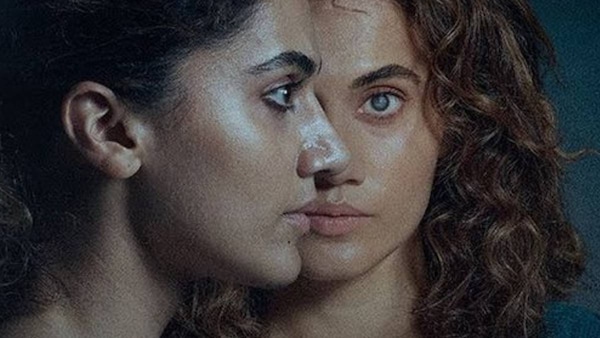Taapsee Pannu's Blurr Remains A Rudimentary Whodunit
In its obsession with the 'Who', Blurr fails to shed light on three basic queries of a suspenseful premise: How, What, and Why.

Last Updated: 02.08 PM, Dec 09, 2022
This is #CriticalMargin, where our critic Ishita Sengupta gets contemplative about new Hindi films and shows.
***
Blurr is the kind of film that lives up to its title — and not in a good way. Ajay Bahl’s film is adapted from the 2010 Spanish psychological thriller Julia's Eyes, but the retelling is sorely univentive, failing to shed light on the three basic queries of a suspenseful premise: how, what, and why. These are crucial shortcomings, for in their absence, the film is not just reduced to a rudimentary whodunnit, it is further diminished to ineffective storytelling.
Gayatri and Gautami (Taapsee Pannu) are twins. One lives in Shimla and the other in Delhi. One day when Gayatri wakes up gasping for breath, she senses something must be amiss with Gautami. She is right. Panicked, Gayatri and husband (a wasted Gulshan Devaiah) arrive in Shimla only to find her sister hanging from the ceiling, dead. The police are certain it is suicide. Apart from the manner of death, there is another reason: Both suffer from a degenerative visual impairment. While Gayatri can still see, Gautami could not. She was awaiting a donor but perhaps her patience ran out. Everyone believes this, except Gayatri. The sisters were estranged but they hadn’t yet drifted so far apart.
Given that it is a thriller, the narrative can bifurcate into two possibilities from here: Gayatri can hunt down the person responsible for her sister’s death. Or, the person can hunt down Gayatri and reveal themselves in the process. Both, in their own way, will be character portraits. Blurr attempts to make a bigger point by turning into a psychological puzzle. The film takes the surface-level premise of the interplay of vision and links it to more metaphorical questions. Can those who have eyes see the world as they should? Does everyone feel as seen as the other? Can physically seeing count as the only route to acknowledging another?
To be fair, this adds a philosophical core to an otherwise straitjacketed murder mystery, expanding its possibilities. It also becomes a shorthand to overlook other screenplay limitations. Like, why is the police so keen on closing the case? Why does Gayatri share an indifferent relationship with her husband? And more importantly, why is an ophthalmologist in charge of showing family members the mortal remains of the deceased? These points seem redundant for Blurr is less curious about who is invisible and more intrigued with the cause and effect of such invisibility. The finger is pointed at us; the innocent are supposed to feel guilty.
But for any film to arouse interest in the psyche of its characters, it must have characters worthy of investing in. It is honestly alarming how little we know of everyone we see on screen. That Gautami was an artist is dismissed in one line. The implications are many: She could have been trained to paying attention, addicted to validation. A life of solitude is not what she sought. How did she cope with the loneliness? We don’t know. Blurr seems equally uninterested in Gayatri. Half an hour before the film is about to end, it is revealed she is an anthropologist. The detail comes so late and so dismissively that it adds nothing to the narrative.
Blurr does start off strong. Pannu, attuned to physically demanding roles, channels the agility accrued by her previous portrayals. The setting helps. The mist and the fog, the burnished light and tempered darkness become literal manifestations of the themes Bahl wants to delve in. You look beyond the minor grouses knowing there is a broader story to arrive. And then something goes off: the third act arrives.
This is when the film loses its bearings, going kaput right at the moment when there are no thrills to hide behind, and questions to answer. At some point, Bahl decides to abdicate all effort and shoot the film to literally hide the identity of the killer. By literally, I mean lowering the gaze of the camera so that we do not see their face while they occupy every frame. I am not sure what was the intent but it comes across as the worst narrative gimmick I have seen in recent times. It is so incredulously lazy, so painfully on the nose that I should have seen what comes next. The killer is revealed and for a film stressing on the need to acknowledge the unseen, the culprit is reduced to a sad caricature, ironically affirming why they were overlooked.
Female actors branching out into a production has become a viable commercial idea. For an industry working overtime to render women disposable, bankrolling films has become a way for them to express their worth and create opportunities that don’t generally exist. Anushka Sharma, Deepika Padukone and Alia Bhatt have taken the leap with their respective banners, making career altering choices in the process. Imagine Pari (Clean Slate Filmz) releasing in theatres today, or another producer willing to put their money on Chhapaak (Ka Productions). Blurr is the first venture from Outsiders Films, Pannu’s production house. For a rank outsider, gaining creative control is the step in the right direction — telling of the position she has built for herself, and preempting a platform that can elevate her artistry. Blurr, however, is not the film that will do it.
Blurr is streaming on ZEE5
